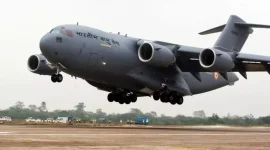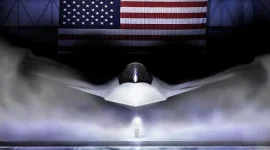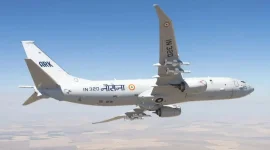- Views: 3K
- Replies: 17
The Indian Air Force (IAF) is currently facing a significant need for more Airborne Warning and Control System (AWACS) aircraft, vital "eyes in the sky" for modern air operations.
American aerospace giant Boeing has proposed its E-7A Wedgetail as a proven, ready-to-use solution. However, sources indicate the IAF remains committed to its own domestically developed Netra Mk1A and MkII AWACS programmes, even though these are expected to take approximately four to five years to become fully operational.
This decision comes even as the Pakistan Air Force (PAF) currently possesses a larger fleet of AWACS aircraft. To address this imbalance, the IAF has a robust plan to acquire twelve new indigenous systems: six Netra Mk1A aircraft, to be built on the Embraer EMB-145 airframe, and six Netra MkII systems, which will utilise modified Airbus A321 passenger jets.
Both Indian models are slated to feature advanced Gallium Nitride (GaN)-based Active Electronically Scanned Array (AESA) radars, considered comparable in capability to the radar on Boeing's Wedgetail. With delivery timelines for the E-7A aligning closely with those of the indigenous programmes, the IAF appears inclined to prioritise self-reliance.
At present, the IAF's AWACS fleet consists of three Israeli Phalcon systems, mounted on Russian Ilyushin Il-76 transport aircraft, and two of the initial indigenous Netra Mk1 systems, which are based on the Brazilian Embraer EMB-145 jet.
This numerical disparity with Pakistan's operational AWACS has raised concerns about India’s ability to maintain comprehensive situational awareness in contested airspace, particularly amid ongoing geopolitical tensions.
AWACS platforms are critical for detecting incoming hostile aircraft, missiles, and drones at long ranges, directing friendly fighter aircraft, and coordinating complex air operations. A shortage of these assets is considered a significant operational constraint for any modern air force.
Boeing’s E-7A Wedgetail, based on the widely used Boeing 737-700 Next Generation airframe, is a battle-proven AWACS platform. It is equipped with the Northrop Grumman Multi-role Electronically Scanned Array (MESA) radar, which offers 360-degree coverage and a detection range reportedly exceeding 400 kilometres.
The aircraft has been adopted by the air forces of Australia, South Korea, Turkey, and the United Kingdom, with recent orders also placed by the United States and NATO, underscoring its reliability.
However, its estimated delivery timeline of three to four years, should India choose to procure it, overlaps with the projected induction of the indigenous Netra Mk1A, diminishing some of its immediate appeal as a stop-gap measure.
The IAF’s firm commitment to the Netra programmes reflects India’s broader ‘Atmanirbhar Bharat’ (self-reliant India) initiative, which prioritises the development and production of defence equipment within the country.
The Netra Mk1A, an upgraded version of the existing Netra Mk1, is being developed by the Defence Research and Development Organisation’s (DRDO) Centre for Airborne Systems (CABS).
These six new systems will also be mounted on Embraer EMB-145 airframes but will feature the more advanced GaN-based AESA radar. This new radar is expected to offer improved detection range (reportedly up to 250–300 km), enhanced electronic countermeasures, and better performance in cluttered electronic environments compared to the earlier Gallium Arsenide (GaAs)-based radar on the Netra Mk1.
The Mk1A is expected to enter service within four to five years, with the first units potentially arriving by 2029.
Further enhancing its airborne surveillance capabilities, the Netra MkII is a more ambitious project. These six larger AWACS will utilise modified Airbus A321 airframes, providing greater flight endurance, the ability to carry a heavier payload, and a longer operational range than the EMB-145 based systems.
The MkII will also incorporate GaN-based AESA radar technology, aligning its core capabilities with sophisticated systems like the Wedgetail’s MESA radar.
The larger airframe of the MkII will allow for additional mission control consoles and a larger crew, enabling extended mission durations and improved command-and-control functions. Development is already underway, with induction into the IAF targeted for the early 2030s.
The use of GaN-based AESA radars in both upcoming Netra variants represents a significant technological leap for India’s defence industry. GaN technology offers higher power efficiency, greater detection range, and better resistance to electronic jamming compared to traditional GaAs radar systems.
This positions the indigenous Netra platforms as competitive alternatives to foreign-built AWACS. Crucially, these advanced radars, developed by DRDO with support from private sector partners, also reduce reliance on foreign suppliers, ensuring long-term sustainability and more cost-effective maintenance.
According to IAF sources, the overlap in delivery timelines between the Wedgetail and the Netra Mk1A is a key factor in the IAF’s current stance.
Procuring the E-7A would entail significant costs – estimated at $1.5 to $2 billion for six aircraft – along with logistical challenges associated with training personnel, establishing maintenance infrastructure, and integrating the new aircraft with existing IAF systems.
In contrast, the Netra programmes leverage India’s existing infrastructure, including operational experience with the EMB-145 platform (used for the current Netra Mk1) and DRDO’s proven track record with the original Netra system, which was successfully deployed during the 2019 Balakot airstrike.
This indigenous approach is seen as promoting smoother integration and lower life-cycle costs.
By prioritising the Netra programmes, the IAF aims to significantly bolster its AWACS capabilities by the early 2030s, envisioning a future fleet of 15 AWACS aircraft (comprising the three existing Phalcons, six Netra Mk1As, and six Netra MkIIs).
This expansion is expected to substantially enhance India’s ability to monitor its vast airspace, coordinate air defence operations effectively, and counter potential aerial threats.
The advanced GaN-based AESA radars on the new Netra systems will also provide a crucial technological edge, enabling the detection of low-observable targets such as stealth aircraft and small drones, a critical capability in modern warfare scenarios.



